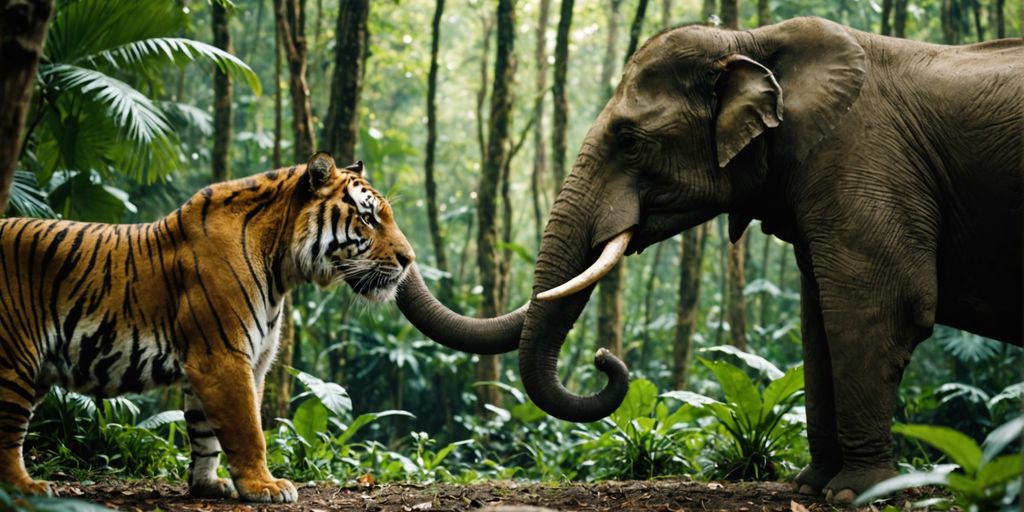Your Cart is Empty
🙏HELP US SAVE TIGERS!🐅 WE DONATE 1% OF OUR SALES TO WILDLIFE ORGANIZATIONS ( WWF ...)
Menu

🙏HELP US SAVE TIGERS!🐅 WE DONATE 1% OF OUR SALES TO WILDLIFE ORGANIZATIONS ( WWF ...)
How Many Tigers Left in India in 2021?
January 25, 2022 3 min read

Tigers are notoriously hard to track and count in the wild, but there are enough reports and data to give us a good idea of how the big cats are faring in India today. Here’s what we know about the tiger population in India, how it has changed over time, and how these big cats will fare in the future.
According to National Tiger Conservation Authority, there are an estimated 2967 tigers left in India in 2021.
Tiger Numbers Drop
The population of Bengal tigers, who inhabit central India and are a subspecies of tiger, has been decimated since 2006, according to research by wildlife advocacy organization TRAFFIC. According to a release from TRAFFIC today, there are only 1,411 Bengal tigers left on Earth. (The species is critically endangered.) In 2006, they estimated that 2,226 Bengal tigers remained—that's a decrease of some 20 percent of their numbers in just six years. This isn't great news for anybody who likes living on Earth or seeing big cats at zoos.
There Are Fewer Than 2,000 Tigers in India
Here's Why, According to a New Report : Fewer than 2,000 tigers are now believed to remain in India. According to a new census report, tiger populations dropped by 40 percent from 2010 through 2014. Deforestation and poaching are largely to blame for these dramatic drops, but conservationists have also struggled with persuading local communities and politicians that saving these majestic animals is important. The last time Indian officials attempted such a survey was 15 years ago—then they counted 3,700 tigers living within 1,470 square miles of protected forests—so it is too early to know if there are fewer tigers today than there were 10 years ago. Additionally, conservationists say it’s hard to gather reliable data on poaching because illegal killings occur away from protected areas and occur at night.
The Indian Tiger Population Has Fallen From ~40,000 to ~3,600
In 2010, a census-estimated that there were around 3,600 tigers left in India. The International Union for Conservation of Nature (IUCN) notes that tiger populations have declined across Asia due to habitat loss and poaching for their pelts. However, according to IUCN, the size of [India’s] population suggests its importance for the long-term conservation of tigers. Since 2010, there has been an uptick in poaching and even an explosion at a fireworks market killed over 20 tigers. That said, many experts believe that if current efforts to conserve tiger habitats continue on course, then populations could rebound within 15 years.

The Government Is Planning a New National Park for the Big Cats
One of Asia’s last tiger strongholds is set to become a national park. The Government of Nepal has declared that its remaining wild tiger population will be protected within an expanded Bardia National Park.
Tigers Invade Human Settlements Due to Their Loss of Habitat
According to National Tiger Conservation Authority, there are an estimated 2967 tigers left in India in 2021. The tiger population is rapidly declining because of many reasons. Habitat loss due to industrialization and deforestation is a primary cause of concern for conservationists, but tigers are also killed by humans and captured for illegal trade. Whether you want to call it poaching or not, tigers have been losing their lives since long before we knew what extinction meant.
Also in Tiger Blog

Sloth Bear vs Tiger: Who Would Win?
July 13, 2024 7 min read
Explore the thrilling showdown between a sloth bear and a tiger, analyzing their strengths, behaviors, and survival tactics.
Read More
Tiger vs Elephant: Who Reigns Supreme in the Animal Kingdom?
July 13, 2024 7 min read
Explore why elephants usually triumph over tigers in the wild, highlighting their size, strength, and defensive prowess.
Read More
Epic Battle: Polar Bear vs Tiger, who win?
July 11, 2024 8 min read
Epic showdown: Polar Bear vs Tiger. Discover who would win in this thrilling battle of nature's fiercest predators.
Read More
